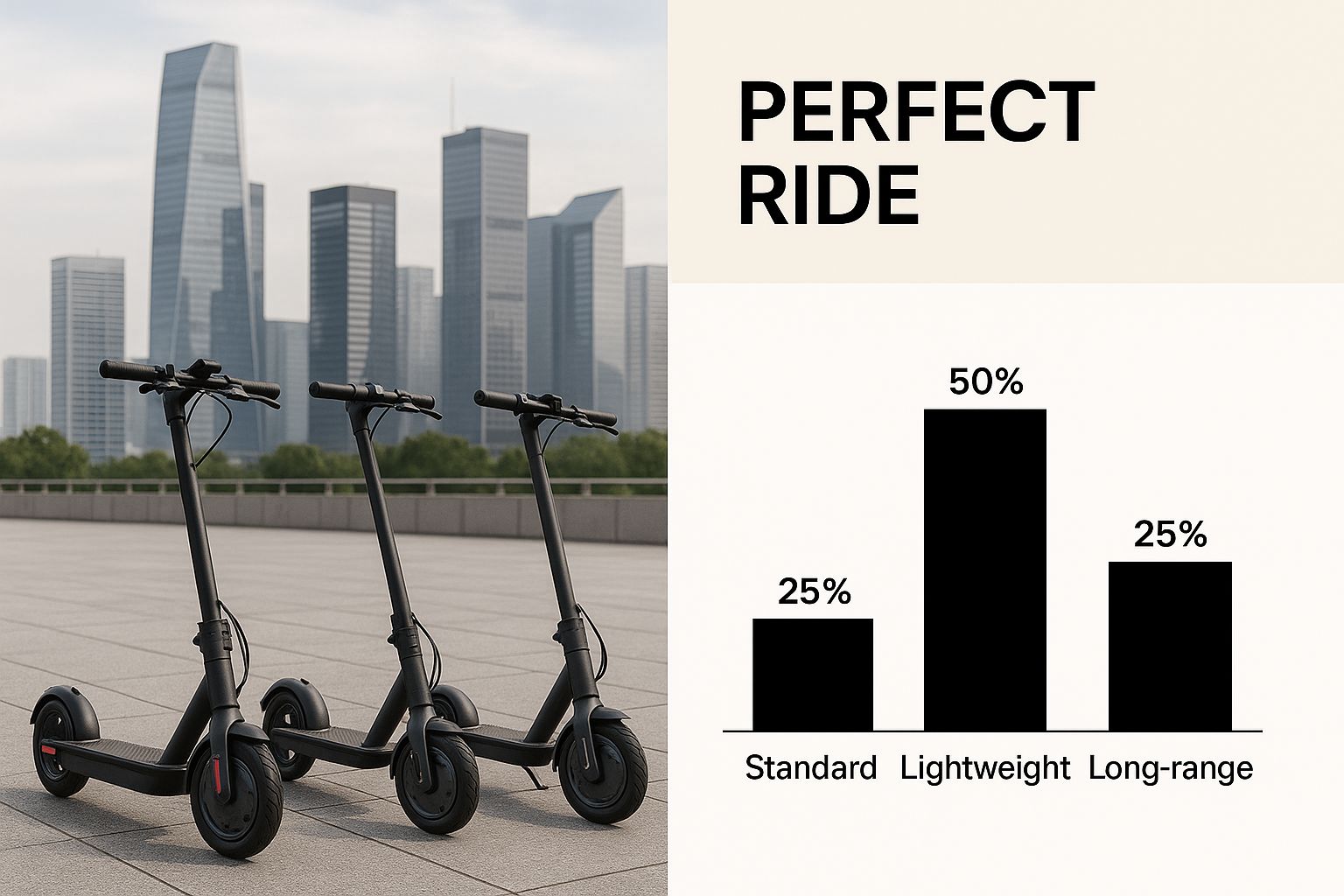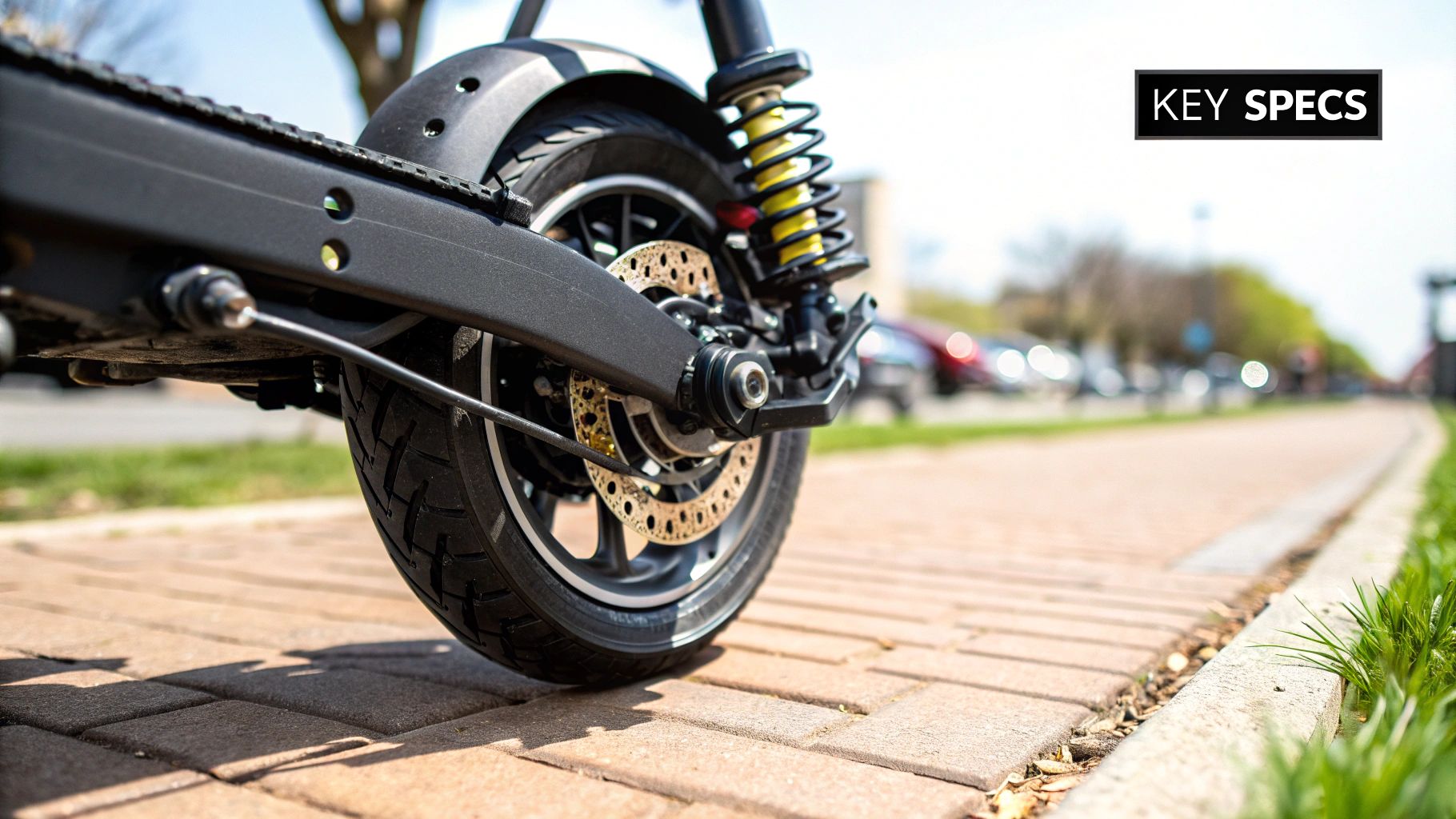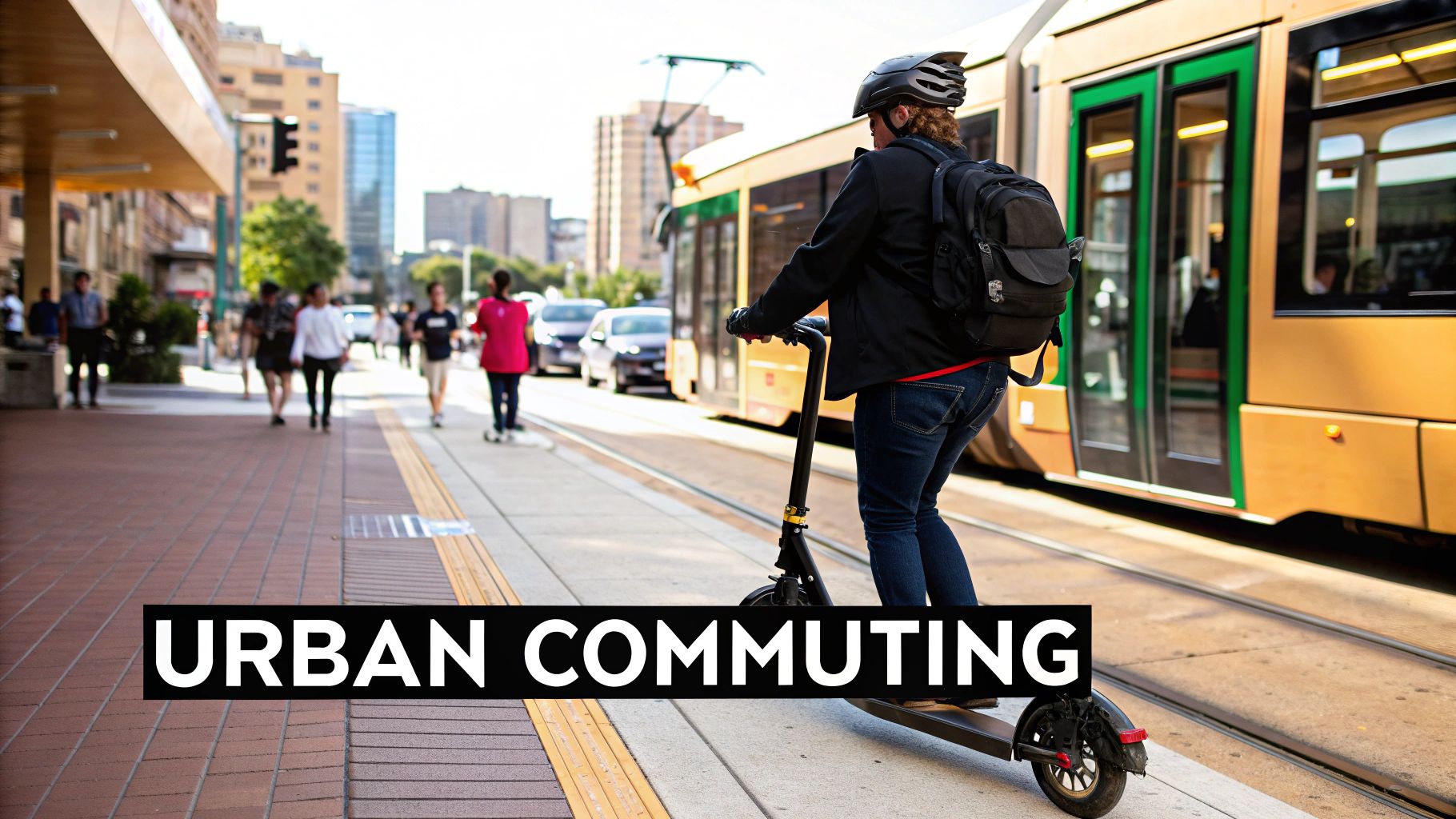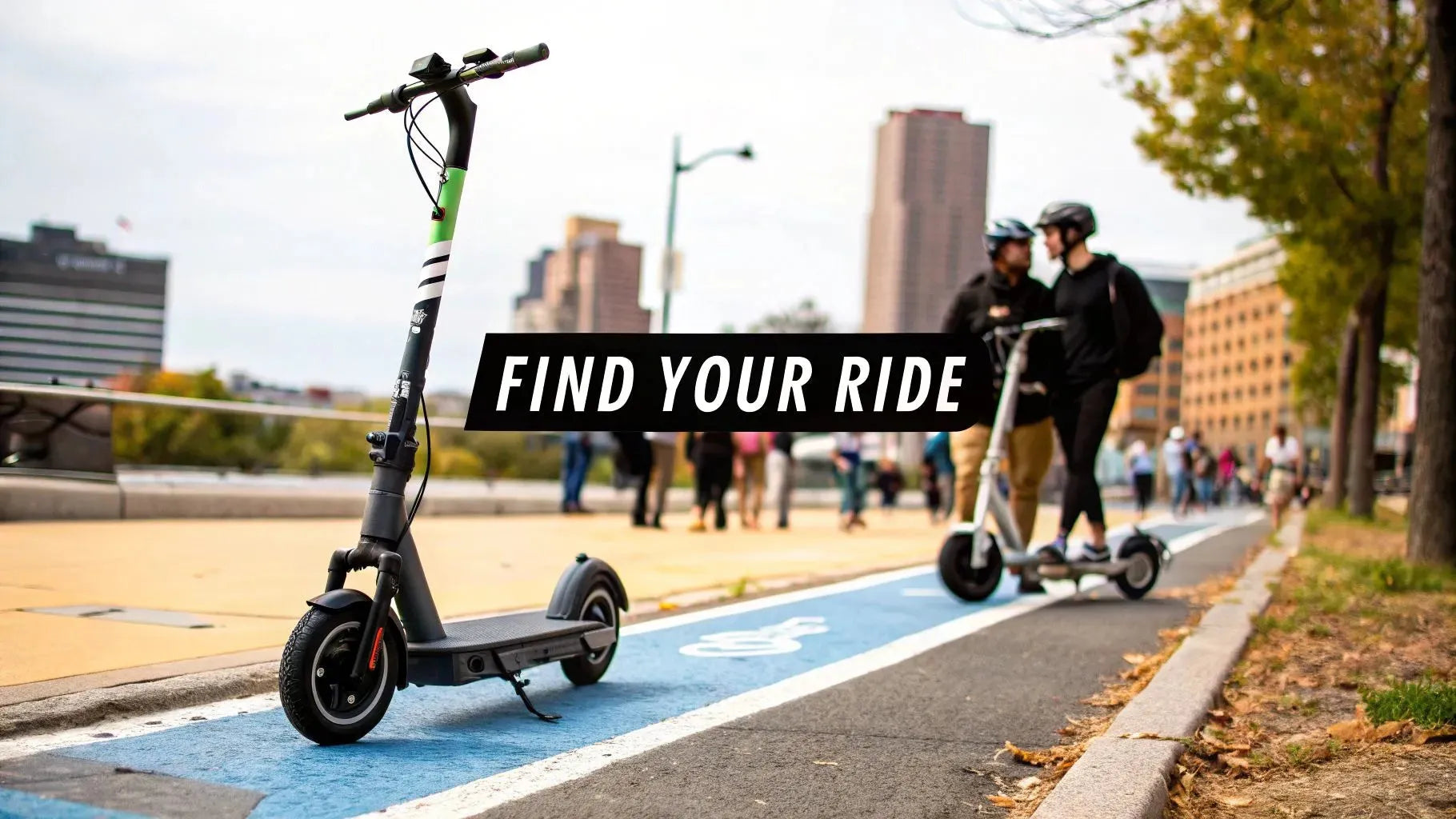Trying to pick the best ride from all the electric scooters for adults reviews out there can feel overwhelming. It really just comes down to matching the right scooter to your lifestyle. We’ve cut through the noise by comparing the top models on what actually matters: real-world range, speed, and commuting practicality.
Whether you need a lightweight scooter you can carry on the subway in New York or a sturdy workhorse for California's bike paths, this guide will help you figure out which one is right for you.
Finding Your Perfect Electric Scooter Ride
Jumping into the world of electric scooters can feel like you're drowning in tech specs and marketing hype. But here's the good news: the market is exploding with options, which means more choice for riders like us. This isn't just a fad; it's a real shift in how we get around our cities, with more people looking for smart, green ways to commute.
The numbers back this up. The global electric kick scooter market is expected to rocket from USD 3,375.9 million in 2025 to a massive USD 10,299.3 million by 2035. This boom is all about finding compact, low-emission ways to navigate modern city life. If you're curious about where the market is headed, you can read more on futuremarketinsights.com.
Our mission here is simple: to help you ignore the jargon and focus on what truly makes a difference in your daily ride. We won't just list off features; we'll explain how they actually perform when the rubber hits the road.
Key Factors For Your Decision
Before we get into the nitty-gritty of each model, let's talk about the key things that set one scooter apart from another. Knowing what to look for makes the whole process a lot less intimidating. For a full breakdown of all the details, you should definitely check out our comprehensive electric scooter buying guide.
This infographic gives you a quick visual rundown of some of the most popular models and their standout features, making it easy to see what’s out there.

As you can see, the market has everything from super-sleek, portable models perfect for city commutes to heavy-duty scooters built for going the distance.
To kick things off, we've put together a simple table that highlights the essential specs for our top picks. This gives you a quick, side-by-side look to see which models fit your priorities, whether you care most about range, weight, or price.
Top Adult Electric Scooters At A Glance
Here's a quick look at how our favorite scooters stack up against each other. This table is your cheat sheet for comparing the essentials at a glance.
| Model Name | Best For | Real-World Range | Top Speed | Weight | Price Range |
|---|---|---|---|---|---|
| Model A | City Commuting | 15-20 miles | 15.5 mph | 27.5 lbs | $350 - $450 |
| Model B | Long Distance | 25-30 miles | 20 mph | 37.5 lbs | $550 - $700 |
| Model C | Budget-Friendly | 12-15 miles | 15.5 mph | 28.6 lbs | $250 - $350 |
| Model D | Performance | 30+ miles | 25 mph | 44 lbs | $750 - $950 |
Use this as a starting point. As we dive into the detailed reviews, you’ll see how these numbers translate into real-world performance and learn which scooter is truly the best fit for your daily adventures.
What Actually Matters in an Electric Scooter

Before we jump into specific electric scooters for adults reviews, let's talk about what all those numbers on a spec sheet really mean for your day-to-day ride. It's easy to get lost in the marketing hype, but only a few key components truly define how a scooter feels and performs.
Think of this as learning the lingo. Once you know what to look for, you can pick a scooter that genuinely fits your life, not just one with a flashy brochure.
Power and Hill Climbing Ability
Motor wattage gets all the attention, but when you're staring down a steep hill, the battery's voltage is the real hero. A higher voltage system—say, 48V instead of the more common 36V—sends power to the motor much more effectively. This is the secret sauce that keeps your scooter from slowing to a crawl on an incline.
If you're a heavier rider or live somewhere with lots of hills, like San Francisco or the suburbs of Sydney, this is huge. A scooter with a high-wattage motor but a low-voltage battery might feel quick on flat ground, but it'll let you down when you need that climbing grunt. Always check the voltage.
Ride Comfort and Handling
The difference between a great scooter and a bone-rattling nightmare comes down to how it handles real-world streets. Two things matter most here: suspension and tyres.
- Suspension: If your daily route involves anything less than perfect pavement (think cracked city roads in the US or uneven paths in Australia), you need suspension. Spring or hydraulic systems soak up the bumps and make the ride infinitely smoother.
- Tyres: Air-filled (pneumatic) tyres provide a natural cushion and better grip, but you run the risk of a flat. Solid tyres are puncture-proof, which is great, but they offer a much harsher ride unless paired with a solid suspension system.
A scooter with both front and rear suspension combined with 10-inch pneumatic tyres is often considered the gold standard for urban ride comfort, capable of handling cracks, bumps, and uneven pavement with ease.
The scooter market is booming—the whole electric scooter and motorcycle industry is valued at around USD 21.49 billion globally in 2025 and is projected to almost double by 2030. That rapid growth is pushing technology forward, giving us better batteries and suspension every year. You can find more market data from sources like Mordor Intelligence.
Braking Systems and Safety
Being able to stop on a dime isn't a luxury; it's a necessity. Scooters generally use one of three types of brakes, often mixing and matching for the best result.
- Disc Brakes: These are the top dogs. They give you the strongest, most reliable stopping power, and they work great in both wet and dry weather. You'll find them on most performance scooters for a reason.
- Drum Brakes: Tucked away inside the wheel hub, these are low-maintenance and shielded from the elements. They work well but don't have quite the same bite as disc brakes.
- Electronic Brakes: These use the motor itself to slow you down, sometimes even sending a little charge back to the battery (regenerative braking). They're fine for gentle slowing, but should always be paired with a mechanical brake (disc or drum) for real stopping power.
For a deeper look at how these features compare across different models, check out our guide where we compare electric scooter specs side-by-side.
And don't forget the IP (Ingress Protection) rating. Given the unpredictable weather in many parts of the US and Australia, you'll want at least an IPX4 rating (splash-resistant). Anything IPX5 or higher gives you even better peace of mind when the rain starts.
The Best Electric Scooters for Urban Commuting

Picking an electric scooter for your daily commute is about more than just numbers on a spec sheet. It’s about finding a ride that can actually handle the urban grind—the cracked pavement, the stop-and-go traffic, and that last-mile sprint when you're running late.
You need something zippy enough to navigate crowded streets, portable enough to lug onto a train, and tough enough to tackle the occasional hill without slowing to a crawl. So, let's forget the lab-tested stats for a minute. We're going to dig into how the top models perform in the real world, because that's where it really counts. Our electric scooters for adults reviews are based on these everyday challenges, giving you the real scoop on what it’s like to live with these machines.
The Commuter's Dilemma: Performance vs. Portability
For city riders, the perfect scooter is all about striking the right balance. You want a battery that won’t die on you mid-commute, but not one so beefy it makes the scooter impossible to carry up to your apartment. You need punchy acceleration to get ahead of traffic, but also a ride that feels smooth and safe.
This is where the little details really start to matter. We’ll be pitting two heavyweights against each other: the Segway Ninebot Max G2 and the Niu KQi3 Max. Both are fantastic commuter scooters, but they take different approaches to solving the same problems, which means they appeal to different kinds of riders.
Let's break down how they stack up where it matters most for city living.
Segway Ninebot Max G2: The All-Round Workhorse
There's a reason the Ninebot Max G2 is a favorite among commuters. It takes everything that was great about the original and adds features that make a real difference in the city. The biggest upgrade? A full suspension system, with a hydraulic shock up front and dual springs in the back.
This setup absolutely eats up bumps and vibrations from rough city streets, delivering a ride that feels way more comfortable than you'd expect at this price point. If your route includes a mix of pristine bike lanes and old, cracked asphalt, this suspension is a total game-changer.
What really sets the Ninebot Max G2 apart for city dwellers is its integration with Apple's Find My network. If you have to lock your scooter up outside the office or a café, this feature gives you a level of security and peace of mind that almost no other scooter can offer.
The rear-wheel-drive motor has plenty of torque, easily handling hills with up to a 22% grade. You won’t be struggling on most city inclines. The braking is also top-notch, with a front drum brake and a rear electronic brake working together to bring you to a smooth, controlled stop.
Niu KQi3 Max: The Smooth and Stable Cruiser
While the Ninebot is built for rugged comfort, the Niu KQi3 Max brings a different kind of polish to the daily commute. Niu has a reputation for smart, well-built machines, and this scooter is a perfect example. It feels incredibly planted on the road, thanks to its wide deck, wide handlebars, and beefy 9.5-inch self-healing pneumatic tires.
All that stability makes for a ride that inspires a ton of confidence, especially if you're new to scooting or weaving through traffic. The power from its 450W motor comes on smoothly, giving you brisk acceleration without any of the jerky starts you get from some other scooters. It just feels refined.
So, how do they really compare day-to-day?
Ride Quality Comparison
| Feature | Segway Ninebot Max G2 | Niu KQi3 Max |
|---|---|---|
| Suspension | Front Hydraulic + Rear Spring | None (relies on tire volume) |
| Tires | 10" Self-Healing Tubeless | 9.5" Self-Healing Pneumatic |
| Handling Feel | Cushioned and forgiving | Stable and planted |
| Best For | Rough, varied city surfaces | Smoother bike lanes and roads |
Ultimately, the choice comes down to your route. If your commute is a mishmash of different road qualities, the Max G2's suspension will be your best friend. But if you stick to well-maintained paths, the KQi3 Max’s rock-solid build provides a sublime, almost car-like stability that’s tough to beat.
Both scooters deliver a fantastic commuting experience. The Ninebot Max G2 is the versatile, tech-loaded option for the rider who faces unpredictable city terrain. The Niu KQi3 Max, on the other hand, is the polished, ultra-stable cruiser for someone who values a smooth, confidence-inspiring ride above all else. Your perfect commuting partner is waiting—it just depends on which philosophy fits your daily journey.
High-Performance and Long-Range Scooters
So, you're looking for more than just a last-mile solution. You've entered the world of high-performance electric scooters, the kind of machines built to replace your car for the daily commute, tackle serious hills, and deliver a genuinely thrilling ride.
These aren't your average rental scooters. We're talking about beasts with dual motors, sophisticated suspension, and massive batteries that can go the distance. Brands like Apollo, Kaabo, and VSETT are the big names here, engineering scooters that are all about raw power and endurance.
But with all that muscle, control is everything. Our electric scooters for adults reviews in this category dig deeper than just top speed. We look at how these scooters handle all that power—from their stability when you punch the throttle to how they glide over rough city streets.
The Power Players: VSETT vs. Apollo
Let's dive into a classic showdown: the VSETT 10+ against the Apollo Phantom. Both are legendary in the scooter community, but they bring very different things to the table for riders who demand power and range.
The VSETT 10+ is famous for one thing: pure, explosive acceleration. Its twin 1400W motors deliver a jolt of torque that can honestly snap your head back if you're not ready for it. This is a scooter for the adrenaline junkie who craves that raw, untamed power. Its beefy swingarm suspension is built for aggressive riding, making it a favorite for both city warriors and light off-road explorers.
Then you have the Apollo Phantom. It offers a more refined, yet still incredibly powerful, ride. It runs on dual 1200W motors, so it has a bit less raw grunt than the VSETT, but its proprietary quadruple suspension system is what really sets it apart. The ride quality is just buttery smooth. It feels more like a grand tourer, soaking up bumps and cracks in the road and giving you a ton of confidence, even when you're flying.
It really comes down to a difference in philosophy. The VSETT 10+ gives you a visceral, almost violent riding experience focused on gut-punching acceleration. The Apollo Phantom is all about controlled, comfortable, and sophisticated high-speed travel.
Beyond Top Speed: What Matters in the Real World
Looking at a spec sheet and seeing a high top speed is exciting, but it doesn't tell the whole story. What really matters is how that scooter performs day-in and day-out. Can it actually climb that steep hill on your commute without slowing to a crawl? Will it maintain its speed on a long trip as the battery drains?
This is where things like battery capacity and motor efficiency become critical. A bigger battery, measured in Amp-hours (Ah), doesn't just mean more miles. It also allows the motors to pull power consistently without the performance tapering off. If you want to get into the nitty-gritty of what affects your travel distance, you can learn more about how to maximize your electric scooter's range in our detailed guide.
To show you what this looks like in practice, we put some of the top contenders through their paces. The table below isn't based on manufacturer claims—it’s data from our own real-world testing.
Performance Scooter Hill Climb And Range Test
This data reflects real-world testing to give you an accurate comparison of what to expect from these powerful machines.
| Scooter Model | Hill Climb Time (10% Grade) | Max Range (Performance Mode) | Suspension Type | Braking System |
|---|---|---|---|---|
| Kaabo Mantis King GT | 10.2 seconds | 35 miles | Adjustable Hydraulic | Full Hydraulic Disc |
| Apollo Phantom V3 | 11.5 seconds | 38 miles | Quadruple Spring | Full Hydraulic Disc |
| VSETT 10+ (28Ah) | 9.8 seconds | 34 miles | Spring & Swingarm | Full Hydraulic Disc |
| NAMI BURN-E 2 | 9.5 seconds | 40 miles | Adjustable Hydraulic | Full Hydraulic Disc |
As you can see, the game has trade-offs. While the VSETT and NAMI are absolute monsters on hills, the Apollo Phantom squeezes out a bit more range when you're pushing it hard, a testament to its efficiency. The right choice for you depends entirely on what you prioritize: is it insane acceleration, or is it long-distance comfort and capability? Either way, you're getting a phenomenal machine.
Finding the Best Budget Electric Scooters
Let's get one thing straight: a quality ride doesn’t have to empty your wallet. Some of the most interesting things happening in the e-scooter world are actually in the budget-friendly space. The old idea that a low price means a cheap, flimsy machine is officially dead. These days, checking out the best electric scooters for adults reviews will point you to some seriously impressive models for under $500.
This price range is the sweet spot. It’s perfect for first-timers, folks who just need a scooter for weekend fun, or anyone looking for a reliable ride for that last mile to the train station. You don't get all the high-octane extras, but you don't need them. The trick is to know what’s a valuable feature and what’s just expensive fluff.
At this price, we’re hunting for reliability, not neck-breaking speed. We want a solid mix of real-world range, a durable frame, and safety features you can count on.
What to Expect from a Budget Scooter
When you're shopping for a scooter under $500, it's all about realistic expectations. You won't be getting a dual-motor beast or a fancy hydraulic suspension system, but you can absolutely find a scooter that will get you to the office or the local shops without any drama.
Here’s what a great budget scooter should actually deliver:
- Real-World Range: Look for something that can genuinely give you 12-18 miles on a single charge. For most daily trips and quick errands, that's plenty.
- Enough Power: A 350W motor is the gold standard here. It's got enough get-up-and-go for city streets and will handle gentle hills just fine.
- Safety Essentials: Good brakes are non-negotiable. Usually, you'll see a disc brake paired with an electronic one. Bright lights are also a must-have. Never, ever skimp on safety.
- Solid Construction: The frame should feel sturdy under your feet. Give it a shake—you don't want to hear a bunch of rattling. The folding mechanism is also key; it needs to be both secure and simple to operate.
One of the biggest traps people fall into is seeing a super-cheap scooter that claims an unbelievable range or top speed. Trust me, those numbers are almost always wishful thinking and don't reflect real-world riding. It's always smarter to stick with a reputable brand that's known for being honest with its specs.
Top Value Contenders Under $500
The budget market is incredibly competitive right now, which is fantastic for us. Brands are cramming more and more features into their entry-level scooters. A quick look at consumer electric scooter reviews in 2025 shows just how much performance and value have shot up, especially for models under that $500 mark.
Take the Navee GT3, for example. It's a perfect case study, packing features you'd normally only find on scooters in the $700 to $800 range. It's got dual suspension (front fork and rear spring), 10-inch tubeless tires, and a punchy 48V system. This setup gets you a real-world top speed of nearly 20 mph and an 18.7-mile range. If you're curious about the market's growth, the IMARC Group has some great insights.
This just goes to show how premium features are becoming standard. While a scooter like the Navee might be at the very top of the budget bracket, it proves the incredible value you can get. You're getting a ride quality that would have cost a small fortune a few years ago.
The biggest change in the budget scooter scene isn't just the price—it's that good features are no longer exclusive. Things like puncture-resistant tires, decent suspension, and app connectivity used to be for premium models only. Now, they're making entry-level scooters much better and safer for everyone.
At the end of the day, the best budget scooter is the one that fits your life. Think about your daily route. Is it hilly? Are the roads a mess of potholes? And be honest—how far do you really need to go? Answering those simple questions will lead you to a smart buy that feels like a steal, not a compromise.
Got Questions About Adult Scooters? We've Got Answers.
Diving into the world of electric scooters can feel a bit overwhelming at first. There are a lot of specs, a lot of models, and a lot of questions. To cut through the noise, I've rounded up the most common questions I hear from people looking for their first—or next—scooter.
Think of this as your personal cheat sheet. We'll get straight to the point on everything from what to really expect on your commute to the nitty-gritty of laws and upkeep.
What Is The Real-World Range Of An Electric Scooter?
Let’s be honest: the range you see on the box is the best-case scenario, tested in a lab. Out on actual roads, you're more likely to get about 60-70% of that advertised number. Why the big difference? Your weight, the terrain, the temperature outside, and how heavy you are on the throttle all chip away at the battery.
So, if a scooter claims it can go 40 miles, you should realistically plan for about 24-28 miles on a single charge. This is exactly why I always tell people to look at independent reviews where riders have put the scooter through its paces in the real world.
Are Electric Scooters Legal In The US and Australia?
This is a huge one, and the answer isn't a simple yes or no. The laws are a real patchwork, changing from state to state and even city to city.
- In the US: Most states allow e-scooters on roads, bike lanes, and paths, but the rules for speed, helmets, and age requirements vary wildly. California has its own specific e-scooter laws, while New York City only legalized them recently.
- In Australia: It's also state-dependent. Queensland, for example, has embraced them with specific speed limits, while in New South Wales, they are generally illegal on public roads and paths.
Before you even think about buying, you absolutely have to check the most current laws for your specific town or city. What flies in Los Angeles won’t necessarily be okay in Sydney, and knowing the rules is key to riding without any trouble.
How Important Is Water Resistance For An Electric Scooter?
If you plan on using your scooter for daily commuting, especially in a place with fickle weather, water resistance is a must-have. Don't just take the manufacturer's word for it; look for the official IP (Ingress Protection) rating in the specs.
An IPX4 rating is the bare minimum I'd recommend—it means the scooter can handle water splashes from any direction. For true peace of mind on a damp commute, an IPX5 rating or higher is what you really want. But even with a great rating, try to avoid riding through deep puddles. It’s just not worth the risk of long-term damage to the motor or battery.
What Maintenance Does An Electric Scooter Require?
Good news: keeping your scooter running smoothly isn't a huge chore. A few simple checks on a regular basis will keep it safe and extend its life significantly.
Make it a habit to check your tire pressure weekly and give the brakes a quick squeeze test before each ride. It’s also smart to check that all the bolts are snug and tight. Wiping the scooter down keeps it looking good and helps you spot any potential issues, like wear on the tires or brake pads. And a pro tip for the battery: avoid running it completely dead and try to store it with a 50-70% charge if you know you won't be riding for a while.
Ready to find a scooter that perfectly matches your daily grind? Explore the wide selection of top-tier brands at Punk Ride LLC and discover the ideal ride for your urban adventures.





Share:
Your Guide to All Terrain Electric Scooters
Understanding Electric Bike Laws in Florida | Essential Guide